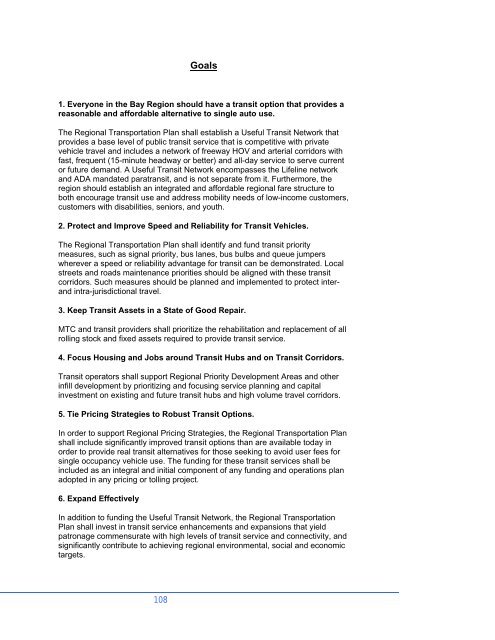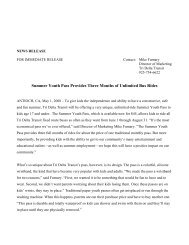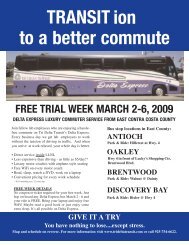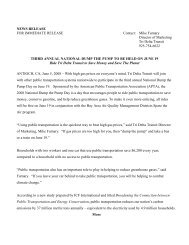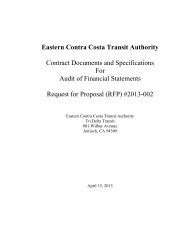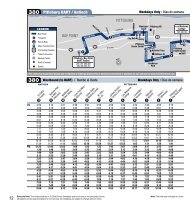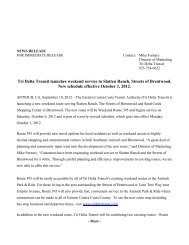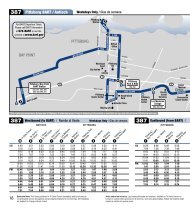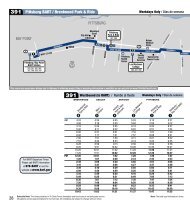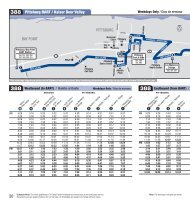to view Short Range Transit Plan FY 2007/2008 - Tri Delta Transit
to view Short Range Transit Plan FY 2007/2008 - Tri Delta Transit
to view Short Range Transit Plan FY 2007/2008 - Tri Delta Transit
Create successful ePaper yourself
Turn your PDF publications into a flip-book with our unique Google optimized e-Paper software.
Goals1. Everyone in the Bay Region should have a transit option that provides areasonable and affordable alternative <strong>to</strong> single au<strong>to</strong> use.The Regional Transportation <strong>Plan</strong> shall establish a Useful <strong>Transit</strong> Network thatprovides a base level of public transit service that is competitive with privatevehicle travel and includes a network of freeway HOV and arterial corridors withfast, frequent (15-minute headway or better) and all-day service <strong>to</strong> serve curren<strong>to</strong>r future demand. A Useful <strong>Transit</strong> Network encompasses the Lifeline networkand ADA mandated paratransit, and is not separate from it. Furthermore, theregion should establish an integrated and affordable regional fare structure <strong>to</strong>both encourage transit use and ad dress mobility needs of low-income cus<strong>to</strong>mers,cus<strong>to</strong>mers with disabilities, seniors, and youth.2. Protect and Improve Speed and Reliability for <strong>Transit</strong> Vehicles.The Regional Transportation <strong>Plan</strong> shall identify and fund transit prioritymeasures, such as signal priority, bus lanes, bus bulbs and queue jumperswherever a speed or reliability advantage for transit can be demonstrated. Localstreets and roads maintenance priorities should be aligned with these transitcorridors. Such measures should be planned and implemented <strong>to</strong> protect interandintra-jurisdictional travel.3. Keep <strong>Transit</strong> Assets in a State of Good Repair.MTC and transit providers shall prioritize the rehabilitation and replacement of allrolling s<strong>to</strong>ck and fixed assets required <strong>to</strong> provide transit service.4. Focus Housing and Jobs around <strong>Transit</strong> Hubs and on <strong>Transit</strong> Corridors.<strong>Transit</strong> opera<strong>to</strong>rs shall support Regional Priority Development Areas and otherinfill development by prioritizing and focusing service planning and capitalinvestment on existing and future transit hubs and high volume travel corridors.5. Tie Pricing Strategies <strong>to</strong> Robust <strong>Transit</strong> Options.In order <strong>to</strong> support Regional Pricing Strategies, the Regional Transportation <strong>Plan</strong>shall include significantly improved transit options than are available <strong>to</strong>day inorder <strong>to</strong> provide real transit alternatives for those seeking <strong>to</strong> avoid user fees forsingle occupancy vehicle use. The funding for these transit services shall beincluded as an integral and initial component of any funding and operations planadopted in any pricing or <strong>to</strong>lling project.6. Expand EffectivelyIn addition <strong>to</strong> funding the Useful <strong>Transit</strong> Network, the Regional Transportation<strong>Plan</strong> shall invest in transit service enhancements and expansions that yieldpatronage commensurate with high levels of transit service and connectivity, andsignificantly contribute <strong>to</strong> achieving regional environmental, social and economictargets.108


